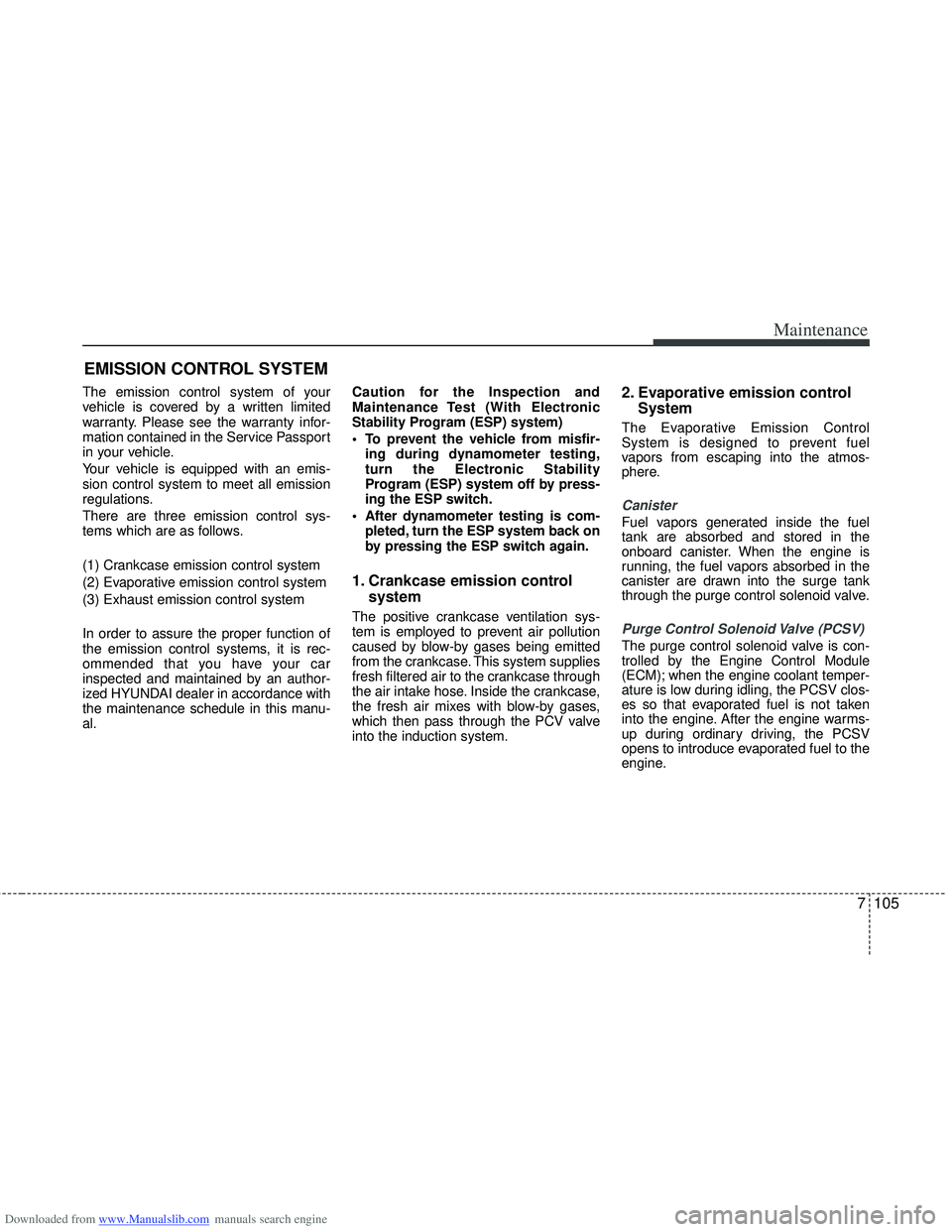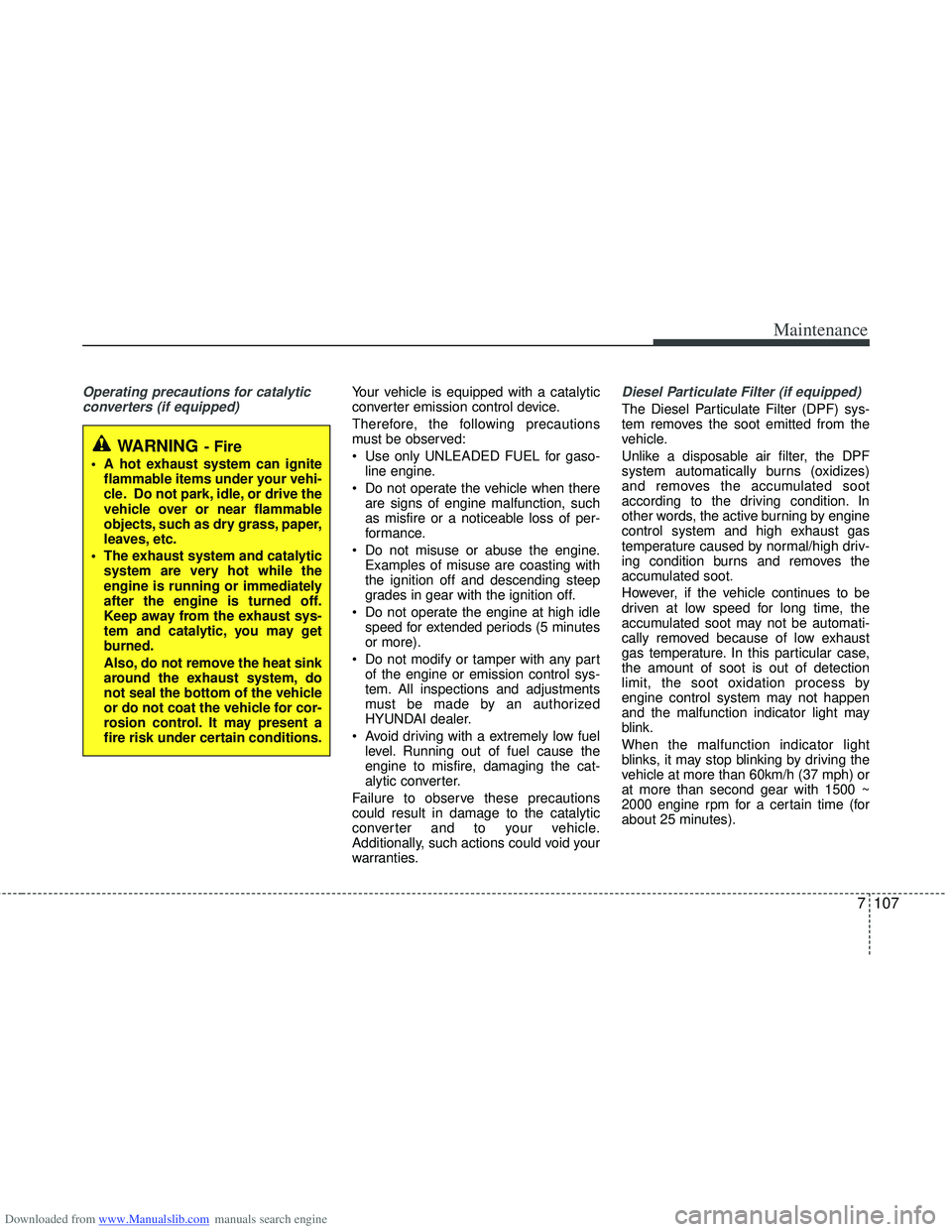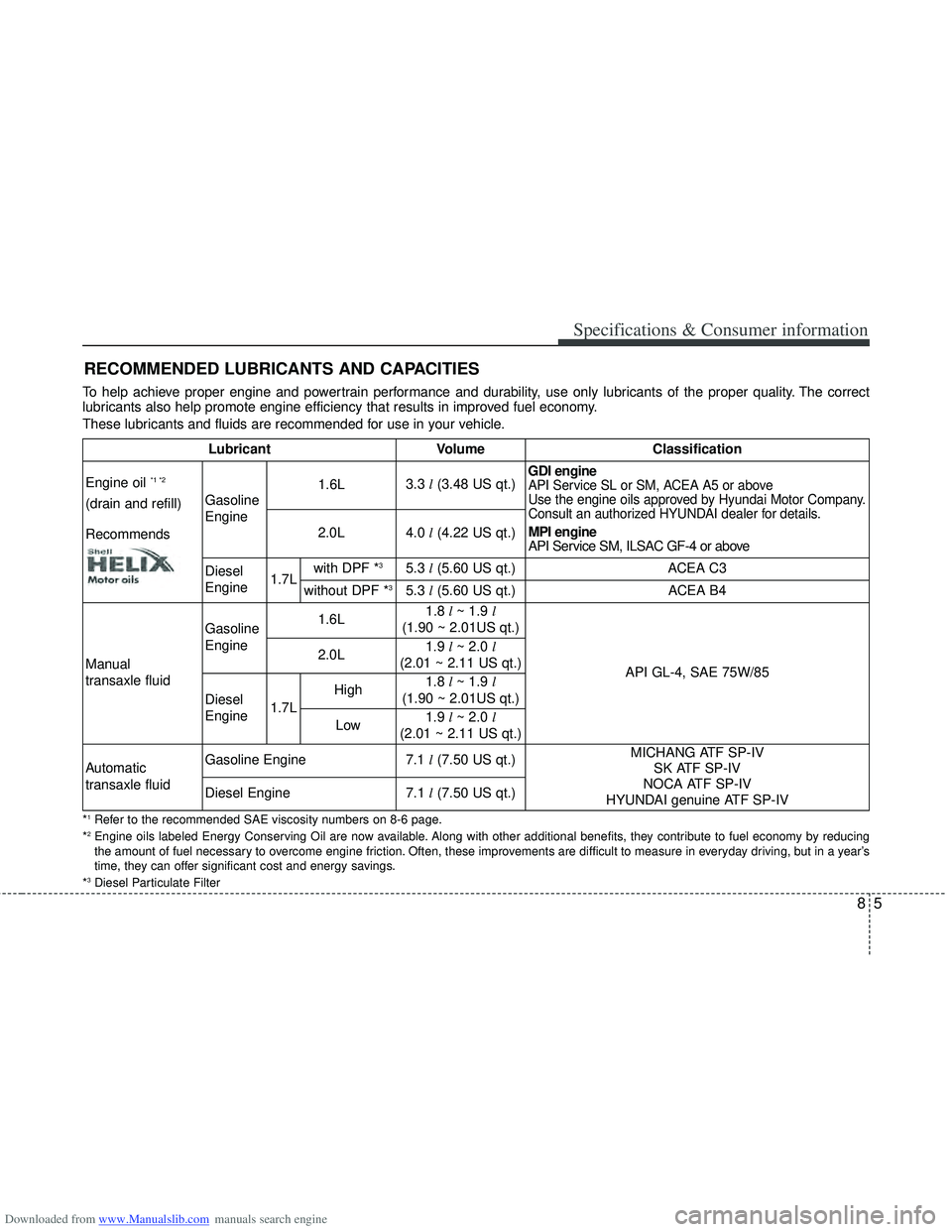2013 HYUNDAI I40 fuel filter
[x] Cancel search: fuel filterPage 481 of 534

Downloaded from www.Manualslib.com manuals search engine Maintenance
76
7
Instrument panel (Driver’s side fuse panel)
No.Fuse ratingSymbol Fuse NameProtected component
120APOWER
OUTLET 2Console Power Outlet, Rear Power Outlet
230APOWER
TAIL GATEPower Tail Gate
310AMODULE 1Smart Key Control Module, BCM, Audio, AMP, JBL AMP, A/V & Navigation Head Unit,
DC-DC Converter (Audio/AMP), Over Head Console Lamp, Parking Guide System,
Power Outside Mirror Switch
410AMODULE 4E/R Fuse & Relay Box (RLY. 12), Stop Lamp Switch, Multipurpose Check Connector,
Active Air Flap Unit, Fuel Filter Warning Sensor (D4FD)
57.5AMODULE 3Smart Key Control Module, BCM, Panorama Sunroof, Rain Sensor,
Driver/Passenger CCS Control Module, ICM Relay Box (Headlamp Washer Relay)
615APOWER
OUTLET 1Front Power Outlet
720AP/SEAT PASSPassenger Manual Switch
810AHTD MIRRDriver/Passenger Power Outside Mirror, ECM/PCM, A/C Control Module
925AAMPAMP, JBL AMP, DC-DC Converter (AMP)
1025AWIPER FRTICM Relay Box (Rain Sensor Relay), Multifunction Switch,
E/R Fuse & Relay Box (RLY. 7), Front Wiper Motor
117.5AA/CONE/R Fuse & Relay Box (RLY. 4), EMS Box (Fuel Heater Relay),
Diesel Box (PTC Heater Relay #2/#3), A/C Control Module
1215ASTEERING
WHEEL HEATERSteering Wheel Heater
Page 510 of 534

Downloaded from www.Manualslib.com manuals search engine 7105
Maintenance
EMISSION CONTROL SYSTEM
The emission control system of your
vehicle is covered by a written limited
warranty. Please see the warranty infor-
mation contained in the Service Passport
in your vehicle.
Your vehicle is equipped with an emis-
sion control system to meet all emission
regulations.
There are three emission control sys-
tems which are as follows.
(1) Crankcase emission control system
(2) Evaporative emission control system
(3) Exhaust emission control system
In order to assure the proper function of
the emission control systems, it is rec-
ommended that you have your car
inspected and maintained by an author-
ized HYUNDAI dealer in accordance with
the maintenance schedule in this manu-
al.Caution for the Inspection and
Maintenance Test (With Electronic
Stability Program (ESP) system)
To prevent the vehicle from misfir-
ing during dynamometer testing,
turn the Electronic Stability
Program (ESP) system off by press-
ing the ESP switch.
After dynamometer testing is com- pleted, turn the ESP system back on
by pressing the ESP switch again.
1. Crankcase emission control system
The positive crankcase ventilation sys-
tem is employed to prevent air pollution
caused by blow-by gases being emitted
from the crankcase. This system supplies
fresh filtered air to the crankcase through
the air intake hose. Inside the crankcase,
the fresh air mixes with blow-by gases,
which then pass through the PCV valve
into the induction system.
2. Evaporative emission controlSystem
The Evaporative Emission Control
System is designed to prevent fuel
vapors from escaping into the atmos-
phere.
Canister
Fuel vapors generated inside the fuel
tank are absorbed and stored in the
onboard canister. When the engine is
running, the fuel vapors absorbed in the
canister are drawn into the surge tank
through the purge control solenoid valve.
Purge Control Solenoid Valve (PCSV)
The purge control solenoid valve is con-
trolled by the Engine Control Module
(ECM); when the engine coolant temper-
ature is low during idling, the PCSV clos-
es so that evaporated fuel is not taken
into the engine. After the engine warms-
up during ordinary driving, the PCSV
opens to introduce evaporated fuel to the
engine.
Page 512 of 534

Downloaded from www.Manualslib.com manuals search engine 7107
Maintenance
Operating precautions for catalyticconverters (if equipped)Your vehicle is equipped with a catalytic
converter emission control device.
Therefore, the following precautions
must be observed:
Use only UNLEADED FUEL for gaso- line engine.
Do not operate the vehicle when there are signs of engine malfunction, such
as misfire or a noticeable loss of per-
formance.
Do not misuse or abuse the engine. Examples of misuse are coasting with
the ignition off and descending steep
grades in gear with the ignition off.
Do not operate the engine at high idle speed for extended periods (5 minutes
or more).
Do not modify or tamper with any part of the engine or emission control sys-
tem. All inspections and adjustments
must be made by an authorized
HYUNDAI dealer.
Avoid driving with a extremely low fuel level. Running out of fuel cause the
engine to misfire, damaging the cat-
alytic converter.
Failure to observe these precautions
could result in damage to the catalytic
converter and to your vehicle.
Additionally, such actions could void your
warranties.Diesel Particulate Filter (if equipped)
The Diesel Particulate Filter (DPF) sys-
tem removes the soot emitted from the
vehicle.
Unlike a disposable air filter, the DPF
system automatically burns (oxidizes)
and removes the accumulated soot
according to the driving condition. In
other words, the active burning by engine
control system and high exhaust gas
temperature caused by normal/high driv-
ing condition burns and removes the
accumulated soot.
However, if the vehicle continues to be
driven at low speed for long time, the
accumulated soot may not be automati-
cally removed because of low exhaust
gas temperature. In this particular case,
the amount of soot is out of detection
limit, the soot oxidation process by
engine control system may not happen
and the malfunction indicator light may
blink.
When the malfunction indicator light
blinks, it may stop blinking by driving the
vehicle at more than 60km/h (37 mph) or
at more than second gear with 1500 ~
2000 engine rpm for a certain time (for
about 25 minutes).
WARNING- Fire
A hot exhaust system can ignite flammable items under your vehi-
cle. Do not park, idle, or drive the
vehicle over or near flammable
objects, such as dry grass, paper,
leaves, etc.
The exhaust system and catalytic system are very hot while the
engine is running or immediately
after the engine is turned off.
Keep away from the exhaust sys-
tem and catalytic, you may get
burned.
Also, do not remove the heat sink
around the exhaust system, do
not seal the bottom of the vehicle
or do not coat the vehicle for cor-
rosion control. It may present a
fire risk under certain conditions.
Page 518 of 534

Downloaded from www.Manualslib.com manuals search engine 85
Specifications & Consumer information
To help achieve proper engine and powertrain performance and durability, use only lubricants of the proper quality. The correct
lubricants also help promote engine efficiency that results in improved fuel economy.
These lubricants and fluids are recommended for use in your vehicle.
RECOMMENDED LUBRICANTS AND CAPACITIES
*1Refer to the recommended SAE viscosity numbers on 8-6 page.
*2Engine oils labeled Energy Conserving Oil are now available. Along with other additional benefits, they contribute to fuel economy by reducing
the amount of fuel necessary to overcome engine friction. Often, these improvements are difficult to measure in everyday driving, but in a year’s
time, they can offer significant cost and energy savings.
*
3Diesel Particulate Filter
Lubricant Volume Classification
Engine oil
*1 *2
(drain and refill)
Recommends Gasoline
Engine
1.6L
3.3
l(3.48 US qt.) GDI engine
API Service SL or SM, ACEA A5 or above
Use the engine oils approved by Hyundai Motor Company.
Consult an authorized HYUNDAI dealer for details.
MPI engine
API Service SM, ILSAC GF-4 or above
2.0L
4.0
l(4.22 US qt.)
Diesel
Engine 1.7Lwith DPF *
35.3
l(5.60 US qt.)
ACEA C3
without DPF *
35.3 l(5.60 US qt.)
ACEA B4
Manual
transaxle fluid Gasoline
Engine
1.6L
1.8
l ~ 1.9 l
(1.90 ~ 2.01US qt.)
API GL-4, SAE 75W/85
2.0L
1.9
l ~ 2.0 l
(2.01 ~ 2.11 US qt.)
Diesel
Engine 1.7LHigh
1.8
l ~ 1.9 l
(1.90 ~ 2.01US qt.)
Low 1.9
l ~ 2.0 l
(2.01 ~ 2.11 US qt.)
Automatic
transaxle fluid Gasoline Engine
7.1
l(7.50 US qt.) MICHANG ATF SP-IV
SK ATF SP-IV
NOCA ATF SP-IV
HYUNDAI genuine ATF SP-IV
Diesel Engine7.1 l(7.50 US qt.)
Page 528 of 534

Downloaded from www.Manualslib.com manuals search engine I5
Index
Flat tire (with spare tire) ..................................................6-8Changing tires................................................................6-9
Compact spare tire .......................................................6-14
Jack and tools ................................................................6-8
Removing and storing the spare tire .............................6-9
Flat tire (with tire mobility kit) .....................................6-21
Floor mat anchor(s) .....................................................4-144
Fluid Brakes/clutch fluid ......................................................7-48
Washer fluid.................................................................7-49
Fog light (front) ...........................................................4-101
Fog light (rear) .............................................................4-101
Folding the rear seat ......................................................3-15
Front seat adjustment .......................................................3-5
Fuel filler lid ..................................................................4-32
Fuel filter .......................................................................7\
-50
Fuel gauge......................................................................4-\
51
Fuel requirements ............................................................1-2
Fuse switch ....................................................................7-73\
Fuses ........................................................................\
......7-71 Fuse switch ..................................................................7-73
Fuse/relay panel description ........................................7-75
Instrument panel fuse ..................................................7-72
Main fuse .....................................................................7-7\
4
Multi fuse ....................................................................7-74\
Gauge
Engine temperature gauge ...........................................4-50
Fuel gauge ...................................................................4-51
Glove box.....................................................................4-1\
36
Glove box lamp............................................................4-110
Hazard warning flasher..................................................4-95
Hazardous driving conditions ........................................5-65
Headlight (Headlamp) escort function ..........................4-96
Headlight (Headlamp) welcome function .....................4-96
Headlight bulb replacement ...........................................7-85
Headlight leveling device ............................................4-102
Headlight position..........................................................4-98
Headlight washer .........................................................4-107
Headrest(front) .................................................................3-8
Headrest(rear) ................................................................3-12
Heated steering wheel....................................................4-42
High - beam operation ...................................................4-99
Height adjustment ..........................................................3-20
Highway driving ............................................................5-67
Hill-start assist control (HAC).......................................5-45
Hood........................................................................\
.......4-30
Horn ........................................................................\
.......4-43
How to use this manual ...................................................1-2
H
GF